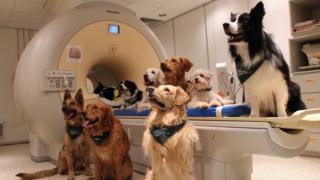 Image copyright Enik Kubinyi / Eotvos Lorand University
Image copyright Enik Kubinyi / Eotvos Lorand University
The science seems to have failed to demonstrate a suspicion with those who live with dogs: these animals understand what and how you will say things.
That is the conclusion reached experts Eotvos Lorand University in Budapest, Hungary, someti Eron dogs to brain scans while receiving orders from their trainers.
the aim of the research, published in the journal Science , was to determine which parts brain used and what understand human language.
“humans love to talk with the dogs all the time” , said principal investigator of the study, animal behavior specialist Attila Andics, the American Association for the Advancement of Science.
“But there is little information on what to take dogs from all that, how they interpret our words. You just processed the tone of our words or even the vocabulary?”.
What they discovered is that dogs intonation process with the right hemisphere and the left hemisphere words . That is, like human beings.
As if this were not enough, able to determine that, beyond intonation, dogs recognize specific words used frequently by their coaches.
However, looking at the brain’s reward area found that animal response was greater when the accolades were accompanied by a positive tone .
According to Andics, this means that dogs “not only separate what we say about how we say it, but also can combine the two for interpreting correctly what these words mean “.
The 13 dogs studied were trained to stand still for 7 minutes while listening to their coaches through headphones and carrying out the scanning procedure called functional magnetic resonance imaging.
Because of the small sample, the Hungarian researchers will continue to analyze the understanding of dogs.
No comments:
Post a Comment